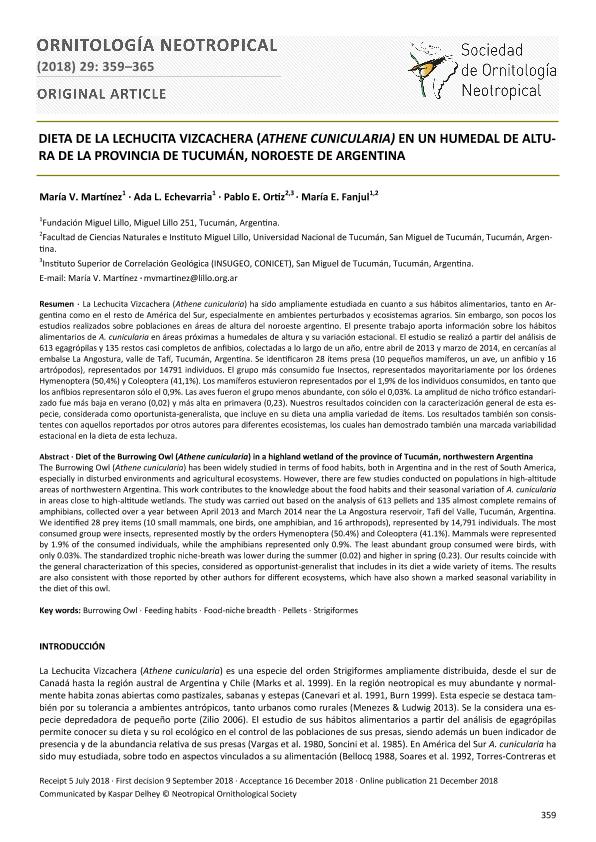Artículo
La Lechucita Vizcachera (Athene cunicularia) ha sido ampliamente estudiada en cuanto a sus hábitos alimentarios, tanto en Argentina como en el resto de América del Sur, especialmente en ambientes perturbados y ecosistemas agrarios. Sin embargo, son pocos los estudios realizados sobre poblaciones en áreas de altura del noroeste argentino. El presente trabajo aporta información sobre los hábitos alimentarios de A. cunicularia en áreas próximas a humedales de altura y su variación estacional. El estudio se realizó a partir del análisis de 613 egagrópilas y 135 restos casi completos de anfibios, colectadas a lo largo de un año, entre abril de 2013 y marzo de 2014, en cercanías al embalse La Angostura, valle de Tafí, Tucumán, Argentina. Se identificaron 28 ítems presa (10 pequeños mamíferos, un ave, un anfibio y 16 artrópodos), representados por 14791 individuos. El grupo más consumido fue Insectos, representados mayoritariamente por los órdenes Hymenoptera (50,4%) y Coleoptera (41,1%). Los mamíferos estuvieron representados por el 1,9% de los individuos consumidos, en tanto quelos anfibios representaron sólo el 0,9%. Las aves fueron el grupo menos abundante, con sólo el 0,03%. La amplitud de nicho trófico estandarizado fue más baja en verano (0,02) y más alta en primavera (0,23). Nuestros resultados coinciden con la caracterización general de esta especie, considerada como oportunista-generalista, que incluye en su dieta una amplia variedad de ítems. Los resultados también son consistentes con aquellos reportados por otros autores para diferentes ecosistemas, los cuales han demostrado también una marcada variabilidad estacional en la dieta de esta lechuza. The Burrowing Owl (Athene cunicularia) has been widely studied in terms of food habits, both in Argentina and in the rest of South America, especially in disturbed environments and agricultural ecosystems. However, there are few studies conducted on populations in high-altitude areas of northwestern Argentina. This work contributes to the knowledge about the food habits and their seasonal variation of A. cunicularia in areas close to high-altitude wetlands. The study was carried out based on the analysis of 613 pellets and 135 almost complete remains of amphibians, collected over a year between April 2013 and March 2014 near the La Angostura reservoir, Tafí del Valle, Tucumán, Argentina. We identified 28 prey items (10 small mammals, one birds, one amphibian, and 16 arthropods), represented by 14,791 individuals. The most consumed group were insects, represented mostly by the orders Hymenoptera (50.4%) and Coleoptera (41.1%). Mammals were represented by 1.9% of the consumed individuals, while the amphibians represented only 0.9%. The least abundant group consumed were birds, with only 0.03%. The standardized trophic niche-breath was lower during the summer (0.02) and higher in spring (0.23). Our results coincide with the general characterization of this species, considered as opportunist-generalist that includes in its diet a wide variety of items. The results are also consistent with those reported by other authors for different ecosystems, which have also shown a marked seasonal variability in the diet of this owl.
Dieta de la lechucita vizcachera (Athene cunicularia) en un humedal de altura de la provincia de Tucumán, noroeste de Argentina
Título:
Diet of the Burrowing Owl (Athene cunicularia) in a highland wetland of the province of Tucumán, northwestern Argentina
Fecha de publicación:
12/2018
Editorial:
Neotropical Ornithological Society
Revista:
Ornitología Neotropical
ISSN:
1075-4377
Idioma:
Español
Tipo de recurso:
Artículo publicado
Clasificación temática:
Resumen
Palabras clave:
Burrowing Owl
,
Feeding habits
,
Pellets
,
Strigiformes
Archivos asociados
Licencia
Identificadores
Colecciones
Articulos(INSUGEO)
Articulos de INST.SUP.DE CORRELACION GEOLOGICA
Articulos de INST.SUP.DE CORRELACION GEOLOGICA
Citación
Martínez, María Valeria; Echevarria, Ada Lilian; Ortiz, Pablo Edmundo; Fanjul, Maria Elisa; Dieta de la lechucita vizcachera (Athene cunicularia) en un humedal de altura de la provincia de Tucumán, noroeste de Argentina; Neotropical Ornithological Society; Ornitología Neotropical; 29; 12-2018; 359-365
Compartir




